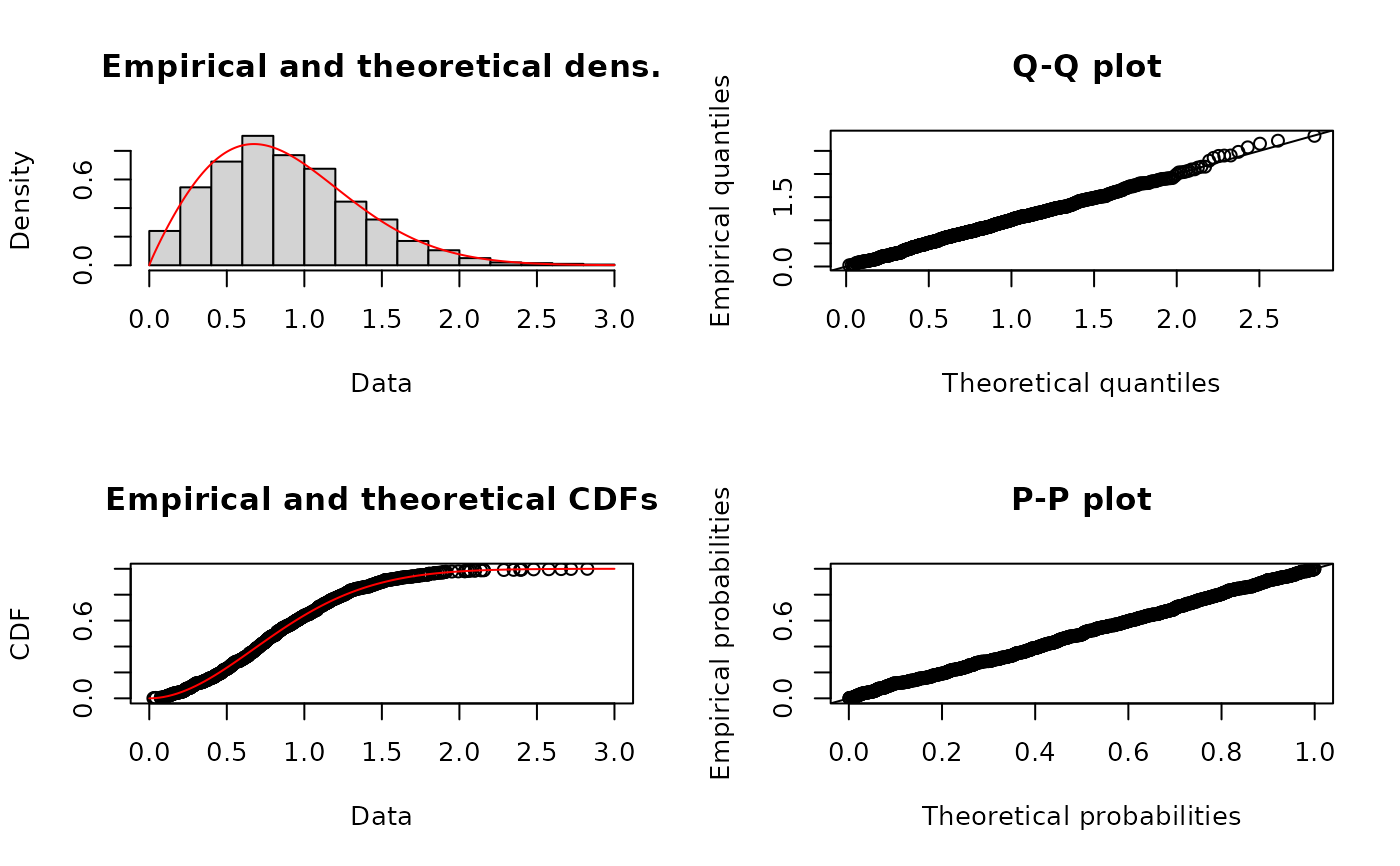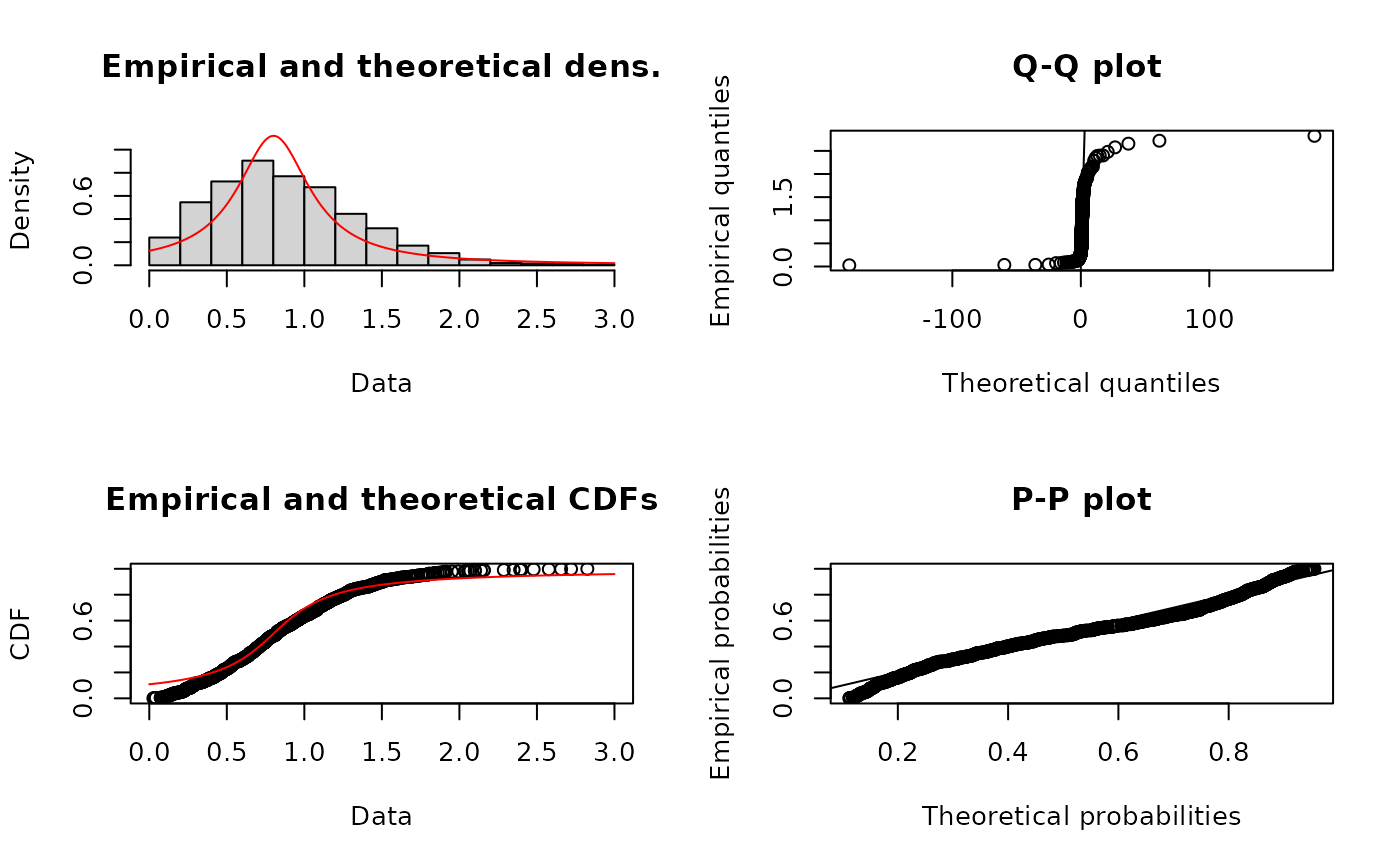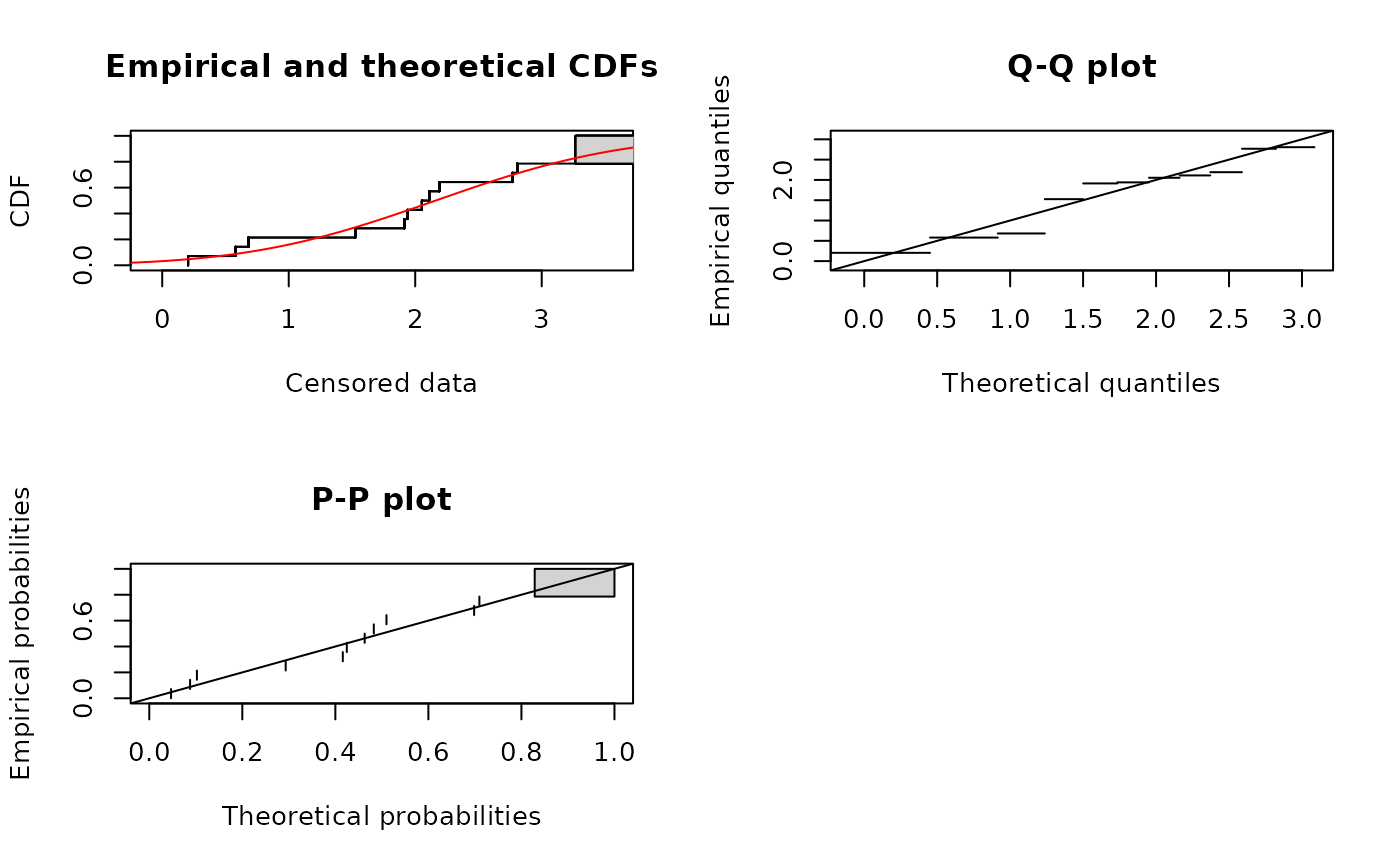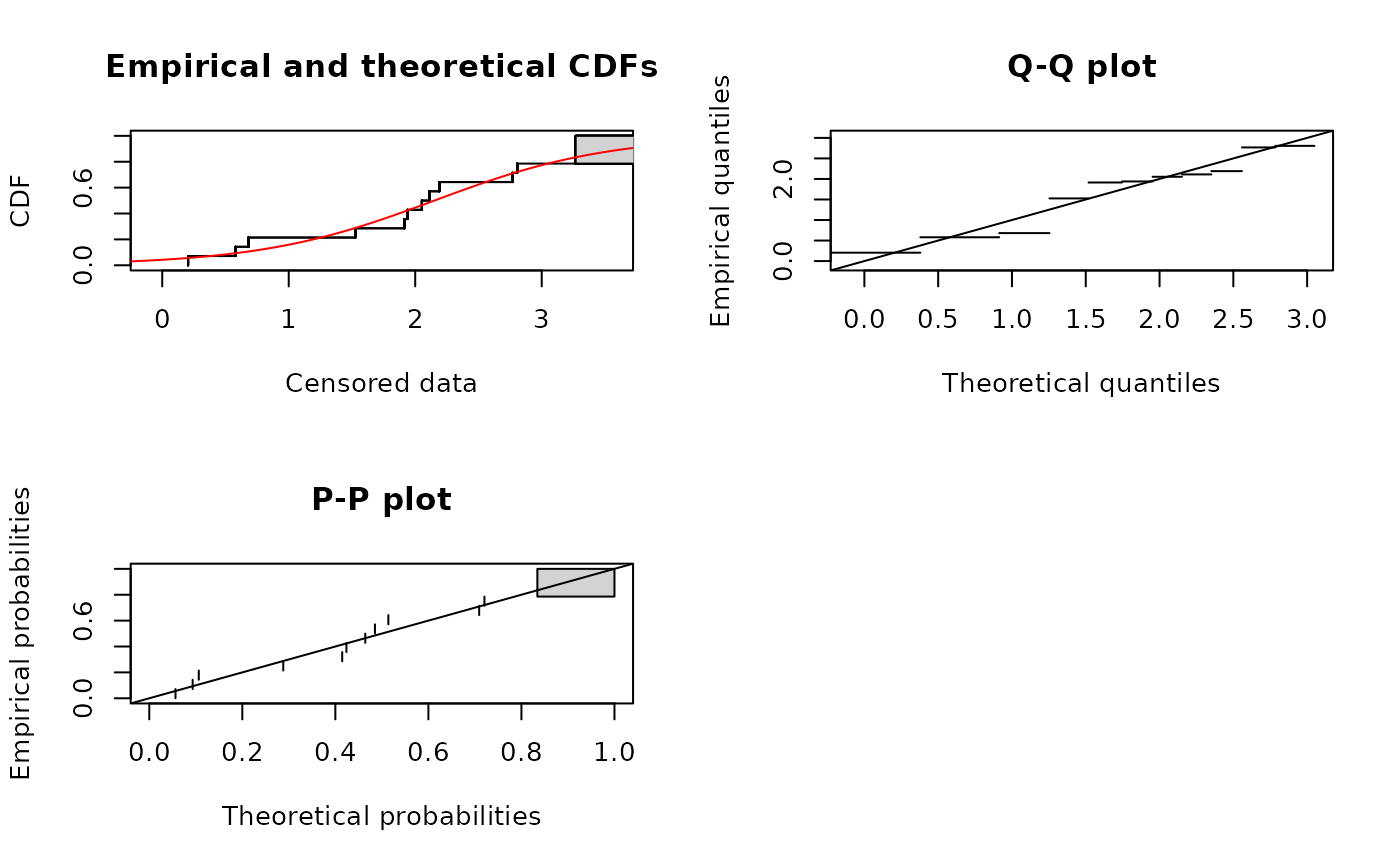Goodness-of-fit statistics
gofstat.RdComputes goodness-of-fit statistics for parametric distributions fitted to a same censored or non-censored data set.
Arguments
- f
An object of class
"fitdist"(or"fitdistcens"), output of the functionfitdist()(resp."fitdist()"), or a list of"fitdist"objects, or a list of"fitdistcens"objects.- chisqbreaks
Only usable for non censored data, a numeric vector defining the breaks of the cells used to compute the chi-squared statistic. If omitted, these breaks are automatically computed from the data in order to reach roughly the same number of observations per cell, roughly equal to the argument
meancount, or sligthly more if there are some ties.- meancount
Only usable for non censored data, the mean number of observations per cell expected for the definition of the breaks of the cells used to compute the chi-squared statistic. This argument will not be taken into account if the breaks are directly defined in the argument
chisqbreaks. Ifchisqbreaksandmeancountare both omitted,meancountis fixed in order to obtain roughly \((4n)^{2/5}\) cells with \(n\) the length of the dataset.- discrete
If
TRUE, only the Chi-squared statistic and information criteria are computed. If missing,discreteis passed from the first object of class"fitdist"of the listf. For censored data this argument is ignored, as censored data are considered continuous.- fitnames
A vector defining the names of the fits.
- x
An object of class
"gofstat.fitdist"or"gofstat.fitdistcens".- ...
Further arguments to be passed to generic functions.
Details
For any type of data (censored or not), information criteria are calculated. For non censored data, added Goodness-of-fit statistics are computed as described below.
The Chi-squared statistic is computed using cells defined
by the argument
chisqbreaks or cells automatically defined from data, in order
to reach roughly the same number of observations per cell, roughly equal to the argument
meancount, or sligthly more if there are some ties.
The choice to define cells from the empirical distribution (data), and not from the
theoretical distribution, was done to enable the comparison of Chi-squared values obtained
with different distributions fitted on a same data set.
If chisqbreaks and meancount
are both omitted, meancount is fixed in order to obtain roughly \((4n)^{2/5}\) cells,
with \(n\) the length of the data set (Vose, 2000).
The Chi-squared statistic is not computed if the program fails
to define enough cells due to a too small dataset. When the Chi-squared statistic is computed,
and if the degree of freedom (nb of cells - nb of parameters - 1) of the corresponding distribution
is strictly positive, the p-value of the Chi-squared test is returned.
For continuous distributions, Kolmogorov-Smirnov, Cramer-von Mises and Anderson-Darling and statistics are also computed, as defined by Stephens (1986).
An approximate Kolmogorov-Smirnov test is performed by assuming the distribution parameters known. The critical value defined by Stephens (1986) for a completely specified distribution is used to reject or not the distribution at the significance level 0.05. Because of this approximation, the result of the test (decision of rejection of the distribution or not) is returned only for data sets with more than 30 observations. Note that this approximate test may be too conservative.
For data sets with more than 5 observations and for distributions for
which the test is described by Stephens (1986) for maximum likelihood estimations
("exp", "cauchy", "gamma" and "weibull"),
the Cramer-von Mises and Anderson-darling tests are performed as described by Stephens (1986).
Those tests take into
account the fact that the parameters are not known but estimated from the data by maximum likelihood.
The result is the
decision to reject or not the distribution at the significance level 0.05. Those tests are available
only for maximum likelihood estimations.
Only recommended statistics are automatically printed, i.e.
Cramer-von Mises, Anderson-Darling and Kolmogorov statistics for continuous distributions and
Chi-squared statistics for discrete ones ( "binom",
"nbinom", "geom", "hyper" and "pois" ).
Results of the tests are not printed but stored in the output of the function.
Value
gofstat() returns an object of class "gofstat.fitdist" or "gofstat.fitdistcens" with following components or a sublist of them (only aic, bic and nbfit for censored data) ,
- chisq
a named vector with the Chi-squared statistics or
NULLif not computed- chisqbreaks
common breaks used to define cells in the Chi-squared statistic
- chisqpvalue
a named vector with the p-values of the Chi-squared statistic or
NULLif not computed- chisqdf
a named vector with the degrees of freedom of the Chi-squared distribution or
NULLif not computed- chisqtable
a table with observed and theoretical counts used for the Chi-squared calculations
- cvm
a named vector of the Cramer-von Mises statistics or
"not computed"if not computed- cvmtest
a named vector of the decisions of the Cramer-von Mises test or
"not computed"if not computed- ad
a named vector with the Anderson-Darling statistics or
"not computed"if not computed- adtest
a named vector with the decisions of the Anderson-Darling test or
"not computed"if not computed- ks
a named vector with the Kolmogorov-Smirnov statistic or
"not computed"if not computed- kstest
a named vector with the decisions of the Kolmogorov-Smirnov test or
"not computed"if not computed- aic
a named vector with the values of the Akaike's Information Criterion.
- bic
a named vector with the values of the Bayesian Information Criterion.
- discrete
the input argument or the automatic definition by the function from the first object of class
"fitdist"of the list in input.- nbfit
Number of fits in argument.
See also
See fitdist.
Please visit the Frequently Asked Questions.
References
Cullen AC and Frey HC (1999), Probabilistic techniques in exposure assessment. Plenum Press, USA, pp. 81-155.
Stephens MA (1986), Tests based on edf statistics. In Goodness-of-fit techniques (D'Agostino RB and Stephens MA, eds), Marcel Dekker, New York, pp. 97-194.
Venables WN and Ripley BD (2002), Modern applied statistics with S. Springer, New York, pp. 435-446, doi:10.1007/978-0-387-21706-2 .
Vose D (2000), Risk analysis, a quantitative guide. John Wiley & Sons Ltd, Chischester, England, pp. 99-143.
Delignette-Muller ML and Dutang C (2015), fitdistrplus: An R Package for Fitting Distributions. Journal of Statistical Software, 64(4), 1-34, doi:10.18637/jss.v064.i04 .
Examples
# (1) fit of two distributions to the serving size data
# by maximum likelihood estimation
# and comparison of goodness-of-fit statistics
#
data(groundbeef)
serving <- groundbeef$serving
(fitg <- fitdist(serving, "gamma"))
#> Fitting of the distribution ' gamma ' by maximum likelihood
#> Parameters:
#> estimate Std. Error
#> shape 4.00955898 0.341451640
#> rate 0.05443907 0.004937239
gofstat(fitg)
#> Goodness-of-fit statistics
#> 1-mle-gamma
#> Kolmogorov-Smirnov statistic 0.1281486
#> Cramer-von Mises statistic 0.6936274
#> Anderson-Darling statistic 3.5672625
#>
#> Goodness-of-fit criteria
#> 1-mle-gamma
#> Akaike's Information Criterion 2511.250
#> Bayesian Information Criterion 2518.325
(fitln <- fitdist(serving, "lnorm"))
#> Fitting of the distribution ' lnorm ' by maximum likelihood
#> Parameters:
#> estimate Std. Error
#> meanlog 4.1693701 0.03366988
#> sdlog 0.5366095 0.02380783
gofstat(fitln)
#> Goodness-of-fit statistics
#> 1-mle-lnorm
#> Kolmogorov-Smirnov statistic 0.1493090
#> Cramer-von Mises statistic 0.8277358
#> Anderson-Darling statistic 4.5436542
#>
#> Goodness-of-fit criteria
#> 1-mle-lnorm
#> Akaike's Information Criterion 2526.639
#> Bayesian Information Criterion 2533.713
gofstat(list(fitg, fitln))
#> Goodness-of-fit statistics
#> 1-mle-gamma 2-mle-lnorm
#> Kolmogorov-Smirnov statistic 0.1281486 0.1493090
#> Cramer-von Mises statistic 0.6936274 0.8277358
#> Anderson-Darling statistic 3.5672625 4.5436542
#>
#> Goodness-of-fit criteria
#> 1-mle-gamma 2-mle-lnorm
#> Akaike's Information Criterion 2511.250 2526.639
#> Bayesian Information Criterion 2518.325 2533.713
# (2) fit of two discrete distributions to toxocara data
# and comparison of goodness-of-fit statistics
#
data(toxocara)
number <- toxocara$number
fitp <- fitdist(number,"pois")
summary(fitp)
#> Fitting of the distribution ' pois ' by maximum likelihood
#> Parameters :
#> estimate Std. Error
#> lambda 8.679245 0.4046719
#> Loglikelihood: -507.5334 AIC: 1017.067 BIC: 1019.037
plot(fitp)
 fitnb <- fitdist(number,"nbinom")
summary(fitnb)
#> Fitting of the distribution ' nbinom ' by maximum likelihood
#> Parameters :
#> estimate Std. Error
#> size 0.3971457 0.08289027
#> mu 8.6802520 1.93501002
#> Loglikelihood: -159.3441 AIC: 322.6882 BIC: 326.6288
#> Correlation matrix:
#> size mu
#> size 1.000000000 -0.000103854
#> mu -0.000103854 1.000000000
#>
plot(fitnb)
fitnb <- fitdist(number,"nbinom")
summary(fitnb)
#> Fitting of the distribution ' nbinom ' by maximum likelihood
#> Parameters :
#> estimate Std. Error
#> size 0.3971457 0.08289027
#> mu 8.6802520 1.93501002
#> Loglikelihood: -159.3441 AIC: 322.6882 BIC: 326.6288
#> Correlation matrix:
#> size mu
#> size 1.000000000 -0.000103854
#> mu -0.000103854 1.000000000
#>
plot(fitnb)
 gofstat(list(fitp, fitnb),fitnames = c("Poisson","negbin"))
#> Chi-squared statistic: 31256.96 7.48606
#> Degree of freedom of the Chi-squared distribution: 5 4
#> Chi-squared p-value: 0 0.1123255
#> the p-value may be wrong with some theoretical counts < 5
#> Chi-squared table:
#> obscounts theo Poisson theo negbin
#> <= 0 14 0.009014207 15.295027
#> <= 1 8 0.078236515 5.808596
#> <= 3 6 1.321767253 6.845015
#> <= 4 6 2.131297825 2.407815
#> <= 9 6 29.827829425 7.835196
#> <= 21 6 19.626223437 8.271110
#> > 21 7 0.005631338 6.537242
#>
#> Goodness-of-fit criteria
#> Poisson negbin
#> Akaike's Information Criterion 1017.067 322.6882
#> Bayesian Information Criterion 1019.037 326.6288
# (3) Get Chi-squared results in addition to
# recommended statistics for continuous distributions
#
set.seed(1234)
x4 <- rweibull(n=1000,shape=2,scale=1)
# fit of the good distribution
f4 <- fitdist(x4,"weibull")
plot(f4)
gofstat(list(fitp, fitnb),fitnames = c("Poisson","negbin"))
#> Chi-squared statistic: 31256.96 7.48606
#> Degree of freedom of the Chi-squared distribution: 5 4
#> Chi-squared p-value: 0 0.1123255
#> the p-value may be wrong with some theoretical counts < 5
#> Chi-squared table:
#> obscounts theo Poisson theo negbin
#> <= 0 14 0.009014207 15.295027
#> <= 1 8 0.078236515 5.808596
#> <= 3 6 1.321767253 6.845015
#> <= 4 6 2.131297825 2.407815
#> <= 9 6 29.827829425 7.835196
#> <= 21 6 19.626223437 8.271110
#> > 21 7 0.005631338 6.537242
#>
#> Goodness-of-fit criteria
#> Poisson negbin
#> Akaike's Information Criterion 1017.067 322.6882
#> Bayesian Information Criterion 1019.037 326.6288
# (3) Get Chi-squared results in addition to
# recommended statistics for continuous distributions
#
set.seed(1234)
x4 <- rweibull(n=1000,shape=2,scale=1)
# fit of the good distribution
f4 <- fitdist(x4,"weibull")
plot(f4)
 # fit of a bad distribution
f4b <- fitdist(x4,"cauchy")
plot(f4b)
# fit of a bad distribution
f4b <- fitdist(x4,"cauchy")
plot(f4b)
 (g <- gofstat(list(f4,f4b),fitnames=c("Weibull", "Cauchy")))
#> Goodness-of-fit statistics
#> Weibull Cauchy
#> Kolmogorov-Smirnov statistic 0.02129364 0.114565
#> Cramer-von Mises statistic 0.06261917 1.854791
#> Anderson-Darling statistic 0.43120643 17.929123
#>
#> Goodness-of-fit criteria
#> Weibull Cauchy
#> Akaike's Information Criterion 1225.734 1679.028
#> Bayesian Information Criterion 1235.549 1688.843
g$chisq
#> Weibull Cauchy
#> 35.76927 306.99824
g$chisqdf
#> Weibull Cauchy
#> 25 25
g$chisqpvalue
#> Weibull Cauchy
#> 7.517453e-02 2.364550e-50
g$chisqtable
#> obscounts theo Weibull theo Cauchy
#> <= 0.1547 36 27.86449 131.86592
#> <= 0.2381 36 34.87234 16.94381
#> <= 0.2952 36 30.58611 14.10775
#> <= 0.3745 36 50.14472 24.12899
#> <= 0.4323 36 41.16340 21.90706
#> <= 0.4764 36 33.55410 19.88887
#> <= 0.5263 36 39.57636 26.45041
#> <= 0.5771 36 41.67095 32.12597
#> <= 0.6276 36 42.36588 37.99145
#> <= 0.669 36 35.03524 35.92961
#> <= 0.7046 36 30.15737 34.26649
#> <= 0.7447 36 33.82481 41.80511
#> <= 0.7779 36 27.74805 36.41317
#> <= 0.8215 36 35.88169 48.69182
#> <= 0.8582 36 29.58833 40.27626
#> <= 0.9194 36 47.80044 62.45332
#> <= 0.9662 36 35.04387 42.03891
#> <= 1.017 36 36.19084 39.23047
#> <= 1.08 36 42.46698 40.45810
#> <= 1.119 36 24.49715 20.76625
#> <= 1.169 36 29.68482 22.91028
#> <= 1.237 36 36.49226 25.22891
#> <= 1.294 36 27.94301 17.49247
#> <= 1.418 36 51.25543 29.00440
#> <= 1.5 36 27.82405 14.64740
#> <= 1.65 36 38.72011 20.11799
#> <= 1.892 36 37.73807 21.69844
#> > 1.892 28 30.30916 81.16036
# and by defining the breaks
(g <- gofstat(list(f4,f4b),
chisqbreaks = seq(from = min(x4), to = max(x4), length.out = 10), fitnames=c("Weibull", "Cauchy")))
#> Goodness-of-fit statistics
#> Weibull Cauchy
#> Kolmogorov-Smirnov statistic 0.02129364 0.114565
#> Cramer-von Mises statistic 0.06261917 1.854791
#> Anderson-Darling statistic 0.43120643 17.929123
#>
#> Goodness-of-fit criteria
#> Weibull Cauchy
#> Akaike's Information Criterion 1225.734 1679.028
#> Bayesian Information Criterion 1235.549 1688.843
g$chisq
#> Weibull Cauchy
#> 6.532102 303.031817
g$chisqdf
#> Weibull Cauchy
#> 8 8
g$chisqpvalue
#> Weibull Cauchy
#> 5.878491e-01 9.318101e-61
g$chisqtable
#> obscounts theo Weibull theo Cauchy
#> <= 0.0264 1 0.9414531 111.941831
#> <= 0.3374 123 118.0587149 63.070591
#> <= 0.6483 222 240.3305518 167.852511
#> <= 0.9593 261 252.4491129 318.542341
#> <= 1.27 204 191.1128355 165.083876
#> <= 1.581 111 112.9380271 62.221846
#> <= 1.892 49 53.8525607 30.121634
#> <= 2.203 19 21.0847217 17.463676
#> <= 2.514 6 6.8505892 11.335604
#> <= 2.825 4 1.8602036 7.933114
#> > 2.825 0 0.5212296 44.432977
# (4) fit of two distributions on acute toxicity values
# of fluazinam (in decimal logarithm) for
# macroinvertebrates and zooplancton
# and comparison of goodness-of-fit statistics
#
data(fluazinam)
log10EC50 <-log10(fluazinam)
(fln <- fitdistcens(log10EC50,"norm"))
#> Fitting of the distribution ' norm ' on censored data by maximum likelihood
#> Parameters:
#> estimate
#> mean 2.161449
#> sd 1.167290
plot(fln)
(g <- gofstat(list(f4,f4b),fitnames=c("Weibull", "Cauchy")))
#> Goodness-of-fit statistics
#> Weibull Cauchy
#> Kolmogorov-Smirnov statistic 0.02129364 0.114565
#> Cramer-von Mises statistic 0.06261917 1.854791
#> Anderson-Darling statistic 0.43120643 17.929123
#>
#> Goodness-of-fit criteria
#> Weibull Cauchy
#> Akaike's Information Criterion 1225.734 1679.028
#> Bayesian Information Criterion 1235.549 1688.843
g$chisq
#> Weibull Cauchy
#> 35.76927 306.99824
g$chisqdf
#> Weibull Cauchy
#> 25 25
g$chisqpvalue
#> Weibull Cauchy
#> 7.517453e-02 2.364550e-50
g$chisqtable
#> obscounts theo Weibull theo Cauchy
#> <= 0.1547 36 27.86449 131.86592
#> <= 0.2381 36 34.87234 16.94381
#> <= 0.2952 36 30.58611 14.10775
#> <= 0.3745 36 50.14472 24.12899
#> <= 0.4323 36 41.16340 21.90706
#> <= 0.4764 36 33.55410 19.88887
#> <= 0.5263 36 39.57636 26.45041
#> <= 0.5771 36 41.67095 32.12597
#> <= 0.6276 36 42.36588 37.99145
#> <= 0.669 36 35.03524 35.92961
#> <= 0.7046 36 30.15737 34.26649
#> <= 0.7447 36 33.82481 41.80511
#> <= 0.7779 36 27.74805 36.41317
#> <= 0.8215 36 35.88169 48.69182
#> <= 0.8582 36 29.58833 40.27626
#> <= 0.9194 36 47.80044 62.45332
#> <= 0.9662 36 35.04387 42.03891
#> <= 1.017 36 36.19084 39.23047
#> <= 1.08 36 42.46698 40.45810
#> <= 1.119 36 24.49715 20.76625
#> <= 1.169 36 29.68482 22.91028
#> <= 1.237 36 36.49226 25.22891
#> <= 1.294 36 27.94301 17.49247
#> <= 1.418 36 51.25543 29.00440
#> <= 1.5 36 27.82405 14.64740
#> <= 1.65 36 38.72011 20.11799
#> <= 1.892 36 37.73807 21.69844
#> > 1.892 28 30.30916 81.16036
# and by defining the breaks
(g <- gofstat(list(f4,f4b),
chisqbreaks = seq(from = min(x4), to = max(x4), length.out = 10), fitnames=c("Weibull", "Cauchy")))
#> Goodness-of-fit statistics
#> Weibull Cauchy
#> Kolmogorov-Smirnov statistic 0.02129364 0.114565
#> Cramer-von Mises statistic 0.06261917 1.854791
#> Anderson-Darling statistic 0.43120643 17.929123
#>
#> Goodness-of-fit criteria
#> Weibull Cauchy
#> Akaike's Information Criterion 1225.734 1679.028
#> Bayesian Information Criterion 1235.549 1688.843
g$chisq
#> Weibull Cauchy
#> 6.532102 303.031817
g$chisqdf
#> Weibull Cauchy
#> 8 8
g$chisqpvalue
#> Weibull Cauchy
#> 5.878491e-01 9.318101e-61
g$chisqtable
#> obscounts theo Weibull theo Cauchy
#> <= 0.0264 1 0.9414531 111.941831
#> <= 0.3374 123 118.0587149 63.070591
#> <= 0.6483 222 240.3305518 167.852511
#> <= 0.9593 261 252.4491129 318.542341
#> <= 1.27 204 191.1128355 165.083876
#> <= 1.581 111 112.9380271 62.221846
#> <= 1.892 49 53.8525607 30.121634
#> <= 2.203 19 21.0847217 17.463676
#> <= 2.514 6 6.8505892 11.335604
#> <= 2.825 4 1.8602036 7.933114
#> > 2.825 0 0.5212296 44.432977
# (4) fit of two distributions on acute toxicity values
# of fluazinam (in decimal logarithm) for
# macroinvertebrates and zooplancton
# and comparison of goodness-of-fit statistics
#
data(fluazinam)
log10EC50 <-log10(fluazinam)
(fln <- fitdistcens(log10EC50,"norm"))
#> Fitting of the distribution ' norm ' on censored data by maximum likelihood
#> Parameters:
#> estimate
#> mean 2.161449
#> sd 1.167290
plot(fln)
 gofstat(fln)
#>
#> Goodness-of-fit criteria
#> 1-mle-norm
#> Akaike's Information Criterion 44.82424
#> Bayesian Information Criterion 46.10235
(fll <- fitdistcens(log10EC50,"logis"))
#> Fitting of the distribution ' logis ' on censored data by maximum likelihood
#> Parameters:
#> estimate
#> location 2.1518291
#> scale 0.6910423
plot(fll)
gofstat(fln)
#>
#> Goodness-of-fit criteria
#> 1-mle-norm
#> Akaike's Information Criterion 44.82424
#> Bayesian Information Criterion 46.10235
(fll <- fitdistcens(log10EC50,"logis"))
#> Fitting of the distribution ' logis ' on censored data by maximum likelihood
#> Parameters:
#> estimate
#> location 2.1518291
#> scale 0.6910423
plot(fll)
 gofstat(fll)
#>
#> Goodness-of-fit criteria
#> 1-mle-logis
#> Akaike's Information Criterion 45.10781
#> Bayesian Information Criterion 46.38593
gofstat(list(fll, fln), fitnames = c("loglogistic", "lognormal"))
#>
#> Goodness-of-fit criteria
#> loglogistic lognormal
#> Akaike's Information Criterion 45.10781 44.82424
#> Bayesian Information Criterion 46.38593 46.10235
gofstat(fll)
#>
#> Goodness-of-fit criteria
#> 1-mle-logis
#> Akaike's Information Criterion 45.10781
#> Bayesian Information Criterion 46.38593
gofstat(list(fll, fln), fitnames = c("loglogistic", "lognormal"))
#>
#> Goodness-of-fit criteria
#> loglogistic lognormal
#> Akaike's Information Criterion 45.10781 44.82424
#> Bayesian Information Criterion 46.38593 46.10235